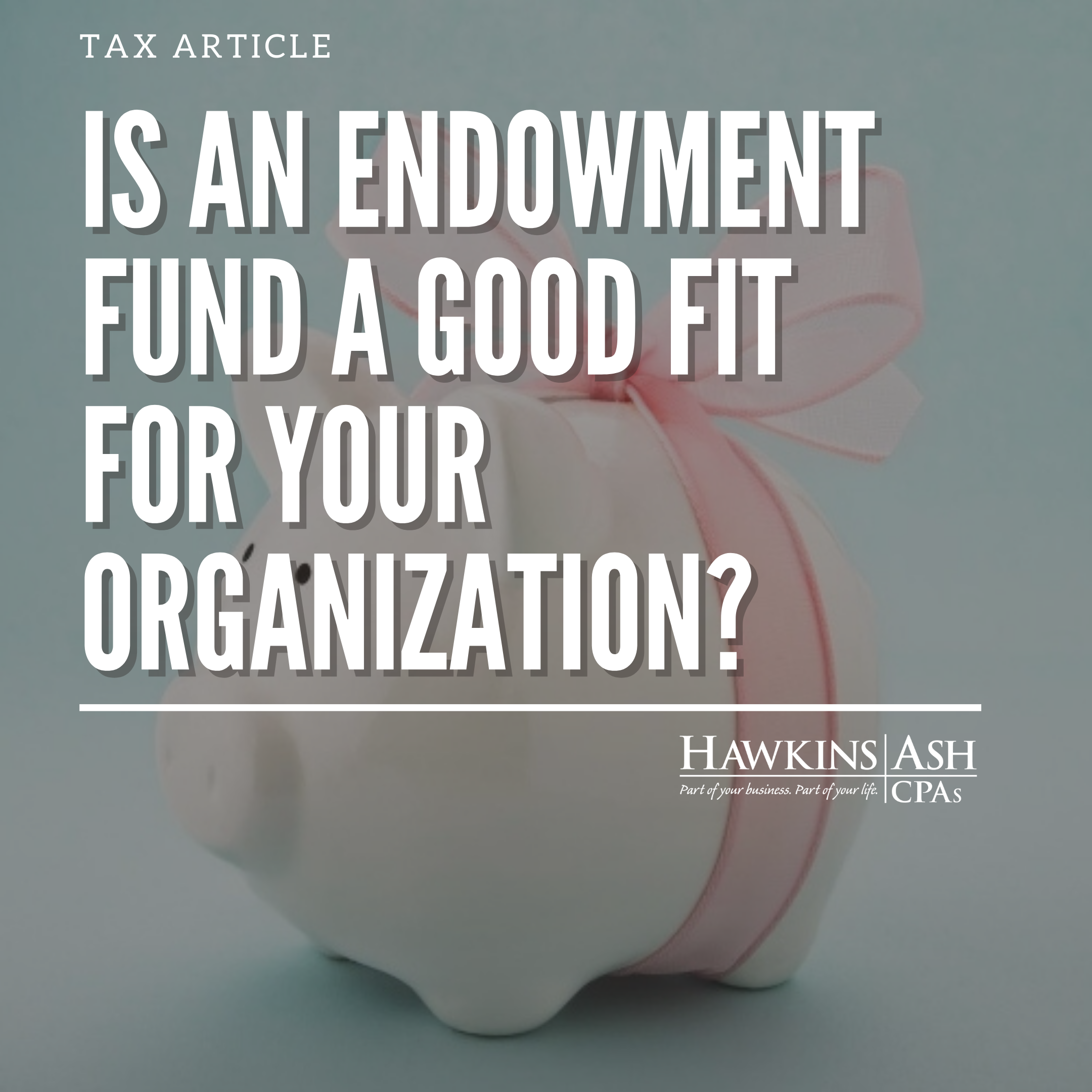Has your organization been thinking about creating an endowment fund? Endowment funds can appeal to donors as a way of providing a long-lasting gift to an organization.
What is an Endowment Fund?
There are certain things to consider as you begin this process. First, you should understand what an endowment exactly is. Endowments are generally donations of cash or other funds received, invested with the purpose of funding the organization’s programs and operations or growing the endowment principal over time with the income earned through the underlying investments.
There are different types of endowments to consider. The most common include true (permanent) endowments and quasi endowments.
True Endowments
True endowments require the principal amount from a donor gift to be held in perpetuity with the intent of it growing in value each year so earnings are available for expenditure as stipulated by the donor or based on the endowment’s purpose. Generally, the principal amount is not invaded to fund annual operating expenses.
Quasi Endowments
Quasi endowments include organization funds directed into an endowment by an individual or group (generally the board of directors) for a specific purpose. A quasi endowment is like a true endowment, but without any restriction to hold the funds permanently. The principal of a quasi endowment can be spent at some future date.
Investment Portfolio or Separate Entity?
You also will want to consider if you should create the endowment as part of your organization’s investment portfolio or create a separate entity to hold the endowment funds. From a practical standpoint, creating an endowment as part of the organization normally makes the most sense. However, creating a separate entity for the endowment would be a consideration if:
- There was an expectation by a donor or funding source that the endowment was separate.
- There would be concerns over potential legal issues (concerns over the fund assets being taken in a lawsuit against the organization).
- There are concerns with funds not being spent as intended or funds being improperly managed.
You should talk with an attorney to determine what option is best for the organization.
How Does the Endowment Operate?
Generally, a document will govern how the endowment operates. This can be done through a trust agreement, board resolution or investment policy. If you choose to hold the endowment funds within your organization, you may also want to consider creating an endowment committee to oversee the operations of the fund.
Be Mindful of UPMIFA
Once the endowment is created, you will want to understand the Uniform Prudent Management of Institutional Funds Act (UPMIFA), which contains rules and standards for nonprofit organizations holding assets for investment purposes, including endowment funds. UPMIFA covers endowment spending and requires that organizations are prudent with their spending of endowment assets. Organizations may determine prudent spending levels across the entire endowment pool (rather than fund-by-fund) based on these seven factors:
- The duration and preservation of the endowment fund
- The purposes of the organization and the endowment fund
- General economic conditions
- The possible effect of inflation or deflation
- The expected total return from income and the appreciation of investments
- Other resources of the organization
- The investment policy of the organization
The organization can apply these seven factors when determining their endowment-spending rate. Generally, a spending rate of between three and five percent of the value of the endowment assets averaged over a period of time (for example, three years) is common.
What Happens If the Endowment Fund Goes “Underwater”?
Occasionally, due to market conditions, the endowment fund may go “underwater,” which means that the fair value of the fund at the reporting date is less than either the original gift amount or the amount required to be maintained by the donor or by law. The goal would be for the market conditions to improve and restore the principal balance over time.
This does not mean you cannot take distributions from the account; you just need to ensure you are being prudent with your spending and following your spending policy. It is important to have documentation showing approval by the governing body for any appropriations from the endowment. The documentation could be as simple as noting the approval in meeting minutes. Consider creating guidelines to address this issue in your spending rate policy.
What About Additional Disclosures?
There are additional disclosures required in financial statements prepared under generally accepted accounting principles (GAAP), so it is important that the organization has documents outlining the endowment fund operations, as well as support for the amounts included in the endowment fund. Examples of what is required to be disclosed include the following:
- Investment policy
- Spending policy
- Aggregate amount of the original endowment gifts
- Aggregate amount of all underwater endowment funds (if any)
- Aggregate amount of investment earnings (This detail will have to be broken out by with donor restrictions and without donor restrictions.)
Because of the additional disclosures required for endowment accounts, it is important that you have procedures in place to identify contributions that have been restricted by donors for the endowment. These amounts should be tracked based on restrictions (both amounts required to be held in perpetuity and any other purpose restrictions). This will be used to allocate the investment income each year to the amounts with donor restriction and without donor restriction, as well as to determine if your endowment is considered “underwater.”
With donor restrictions will include the amounts required to be held in perpetuity (previously called “permanently restricted”), as well as any amounts with purpose restrictions (previously called “temporarily restricted”). Under Accounting Standards Update 2016-14, organizations are now required to account for amounts underwater in the “with donor” restriction category of net assets.
Complex Considerations
In summary, the setup, accounting and reporting for endowments can be complex. But if done properly, you will create tremendous benefits for your organization and guarantee an ongoing source of income for years to come.
Please contact your Hawkins Ash CPAs representative if you have questions related to the setup, accounting and reporting of an endowment fund.





